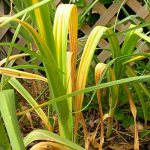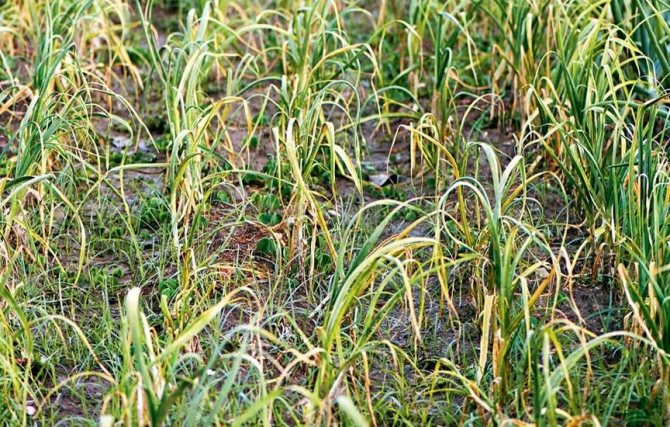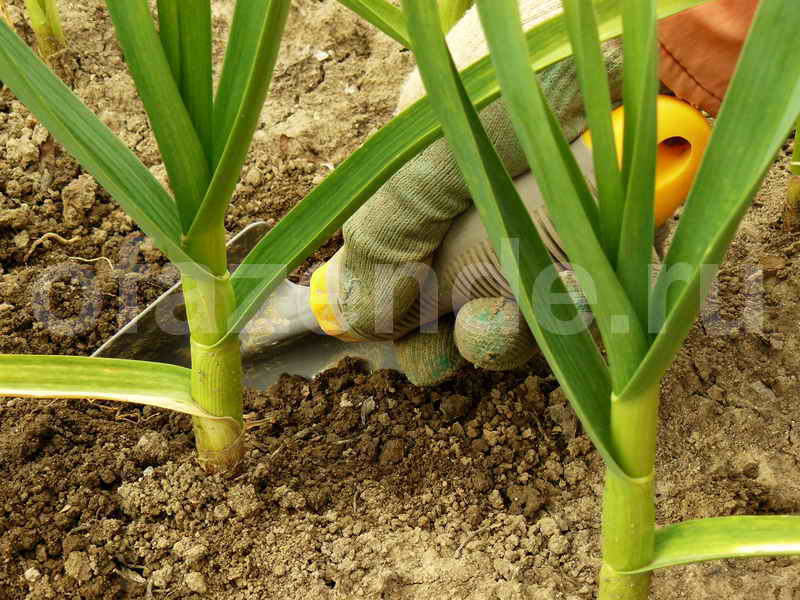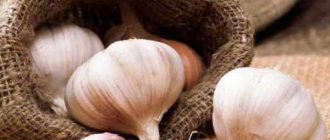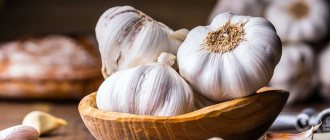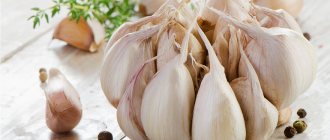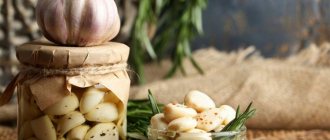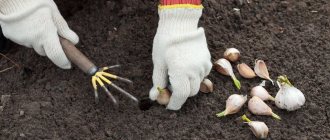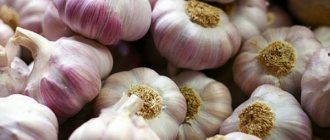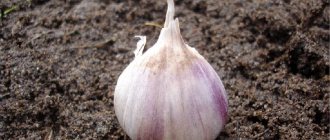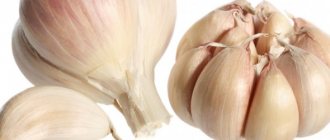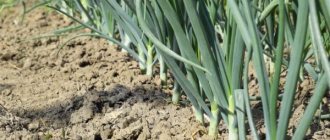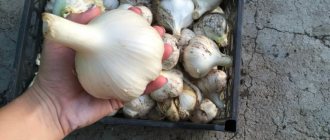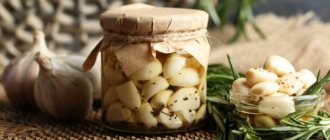It often happens that a gardener sows garlic and expects a good harvest, but it turns yellow in the garden in the spring, and then fades altogether. There are many factors that can trigger this phenomenon. In most cases, this concerns improper planting and processing, lack of certain trace elements or pest activity.
In healthy garlic, the leaves located below begin to acquire a yellowish tint only in the second half of summer. This is a sign that the harvest is already possible.
It often happens that a gardener sows garlic and expects a good harvest, but it turns yellow in the garden in the spring, and then fades altogether. There are many factors that can trigger this phenomenon. In most cases, this concerns improper planting and processing, lack of certain trace elements or pest activity.
In healthy garlic, the leaves located at the bottom begin to acquire a yellowish tint only in the second half of summer. This is a sign that the harvest is already possible.
- autumn or winter;
- spring or spring.

Both methods have their own advantages and disadvantages. When the garlic is planted in the fall, the harvest will be rich. But it is allowed to store it for no more than 6 months. But planted in spring can be stored for up to a year, but the volume of the harvest is not the greatest.
If planted too early in the fall, then winter garlic sprouts even before the first frost begins. That is, he does not have time to prepare for wintering. Early seedlings will start to turn yellow due to frost. Spring plantings can have the same problem, for example, if there is still a high probability of frost in the region in May or April.
During planting, you should carefully monitor the temperature regime. Sowing garlic is recommended on time - not in advance, but without delay. Sometimes, when they want to play it safe, planting is carried out for the winter even at the beginning of December, and the spring planting is already in the first weeks of May.
An important indicator that affects the state of the foliage of a plant is the level of acidity of the soil. If this parameter is too high, then it is very harmful for garlic.
Watering is also an important factor in keeping the foliage green and supple. In a dry summer, you need to water the plant generously, otherwise not only the ground part will wither, but the bulbs will not be able to fully develop. To keep water in the soil longer, you can use mulching the beds. It is recommended to use straw for this. But overflows should not be allowed, as this will also harm the plant, forming an environment that is optimal for the development of fungal diseases. It is important to monitor the quality and temperature of the water. It shouldn't be too cold. It is better if she stands in the sun for a while.
Errors during landing
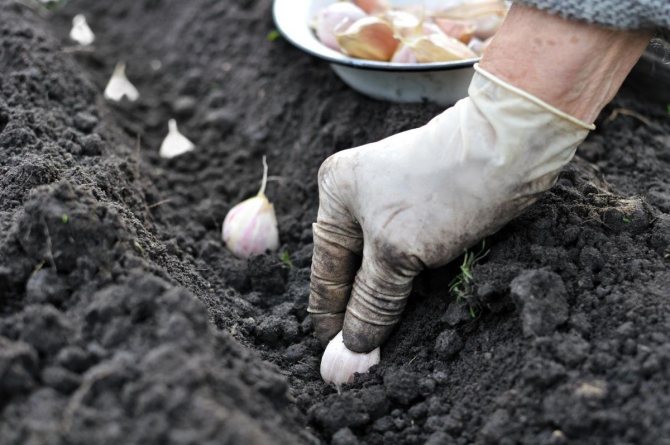

Usually gardeners sow garlic before winter. The reason for this choice lies in the large selection of winter varieties and good yields. Such cloves are lowered into the soil in the fall so that they take root, but do not have time to release the arrows. If the planting material is planted too early, leaves have time to grow. Then, due to frost, they turn yellow.
A good prevention of yellowing in this case will be the timely planting of garlic.The choice of the term for each locality is influenced by the climate of the growing region. In the northern part of the country, early planting is practiced. The optimal time is mid-October. In the south, in a warm climate, planting is performed in November.
Another reason for the yellowness of the leaves is the wrong technique for planting garlic. Then the sprouts that appear in the spring look weak and sick. This happens when the planting material is not deeply embedded. Because of this, the bulbs freeze under winter conditions. Yellowing of the arrowheads is a sign of such damage. Sometimes the entire leaf completely changes its color to light green or yellow.
Deep embedding of the planting material will help to avoid this. The teeth need to be lowered to a depth of 4 to 6 cm. If in winter the temperature often drops to critical values, the planting site is additionally covered with a layer of mulch to prevent freezing.
As a covering material for a garlic bed, use:
- peat;
- humus;
- straw;
- fallen leaves.
In order for the garlic to successfully overwinter under a shelter, it is laid in a layer of more than 6 cm.If dry foliage or straw was used as mulch, they are removed after the snow melts.
Important! It is possible to save frozen garlic and eliminate yellowness only by providing the plants with good care.
Preventive measures
We figured out why garlic turns yellow in spring. Diseases are the main cause of yellowing. In order not to think about how to treat crops affected by certain diseases, it is necessary to carry out prevention even before the vegetable begins to wither and turn yellow.
Regardless of why the garlic turns yellow in the garden, the preventive measures will not differ.
- Most bacteria, fungi and parasitic insects live in the ground, so the main preventive measure is crop rotation. Every year they try to change the landing site. Diseases also accumulate in the white teeth themselves, so the seed is periodically updated. This is done at least once every 3 years.
- Before planting, white cloves are treated in a fungicide. This makes the plant resistant to many bacterial and fungal diseases.
- Marigolds or calendula are planted along the perimeter of the beds with this vegetable crop. These plants smell away from parasites that move through the air (for example, onion flies). And their roots are poisonous to some insects in the soil. In particular, they kill the stem nematode, which is one of the most dangerous diseases of this vegetable crop.
- Onions should be planted next to the vegetable, which also repels some pests.
- If fungal diseases are detected, the affected plants are removed from the site, and the rest are treated with systemic fungicides.
- Pest prevention is another mandatory preventive measure against diseases.
There are not so many objective reasons for the appearance of yellowness on young greenery. If you quickly determine why young garlic turns yellow, you can eliminate the problem by minimizing crop losses.
Late frosts
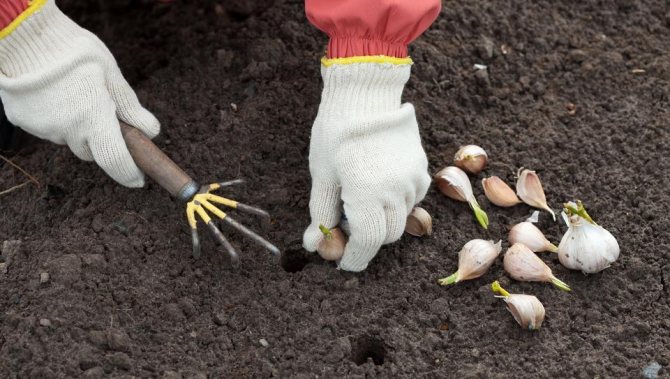

Some gardeners are in too much of a hurry to remove their winter shelter. Then the soil freezes due to recurrent frosts. To prevent freezing of the surface layer of the soil, mulching is used. The cover layer stores the warmth of the sun's rays throughout the day. Then at night the soil will be more protected from the effects of cold.
Often it is not the cold air itself that is dangerous, but its effect on plants along with the wind. In such conditions, it cools the plants more strongly. To protect from the cold wind, boards, slate or pieces of plastic are installed along the perimeter of the ridge. Such an obstacle will reduce the wind speed and help avoid hypothermia. You can reduce the effect of low temperatures on plants by covering the garden bed at night with a non-woven cloth. It is more convenient to do this using arcs.To restore frozen plants, top dressing is used with the preparations "Epin" or "Zircon".
How to fix the problem
Check out these articles as well
- How to deal with scab on an apple tree
- Insecticide Aktara
- Crocus flower
- Wild garlic
Depending on the cause of the yellowing of the leaves, the solution to the problem may be different.
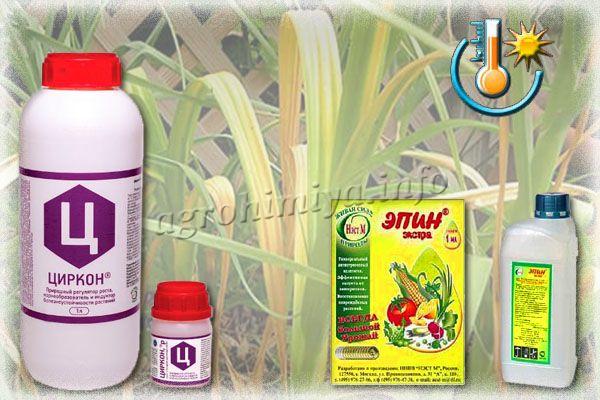

After spring frosts, garlic must be treated with Zircon or Epin preparations.
- In the case of an incorrect, thickened planting, thinning is necessary. There should be at least 7 cm of free space between the cloves of garlic, and the row spacing is 15-20 cm! Thinning will save most of the crop. In addition, it does not hurt to feed the culture to restore strength.
- Sour soil can also cause leaves to turn yellow. To cope with this problem, dolomite flour or a similar agent must be added between the rows and the plants.
- If the matter is in spring cold snaps, a protective film, agrofibre is used for protection. And after the returnable spring frosts have passed, it is necessary to treat the plantings with a growth stimulant like "Zircon", "Epin" or the like.
- When plants are low on water, watering should be increased. You can add water at the root or on the leaf, but only in the early morning or at sunset, and not at the peak of solar activity.
Interesting!
For watering garlic, it is best to use collected rainwater or simply settled, warm.
Lack of nutrients


Cold soil in spring reduces the rate of mineral salts formation. Therefore, winter garlic sometimes suffers from nutritional deficiencies. Lack of nitrogen can be recognized by the following:
- pale green or yellowish color of the leaves;
- lethargic and small shoots.
If the plant does not have enough potassium, its water metabolism is disturbed, it is more likely to get sick due to a decrease in the strength of the immune system. The symptoms of potassium starvation are:
- bluish tint of foliage;
- browning of garlic arrows at the edges;
- slow leaf development.
To compensate for the lack of nutrition, fertilizing is used. They can be applied dry by watering the plants under the root or by spraying the foliage.
To apply dry dressing, the soil is loosened between the rows of garlic. Then furrows are made with a depth of 2 cm. Urea or mineral complex fertilizers with a high nitrogen content are placed in them. The furrow is covered with soil and the garlic plantings are generously watered with water. The moisture dissolves the fertilizer granules, then they go to the roots of the plant. To reduce evaporation, the planting site is mulched with compost.
To water the garlic at the root, nitrogen fertilizers are also used. In 10 liters of warm water, dissolve 1 tbsp. l. urea granules or any complex fertilizer with a large amount of nitrogen. This solution is poured over a garlic bed. A bucket of mortar is enough to handle 1 square meter of plantings.
To sprinkle garlic on the leaf, use a solution of potassium sulfate or mineral complexes with a large amount of this element. In the first case, the consumption rate is 1 tsp for 10 liters of water. drug. If the solution is prepared with complex fertilizer, they rely on the instructions for it. The resulting product is sprayed onto the plants.
Causes of yellowing
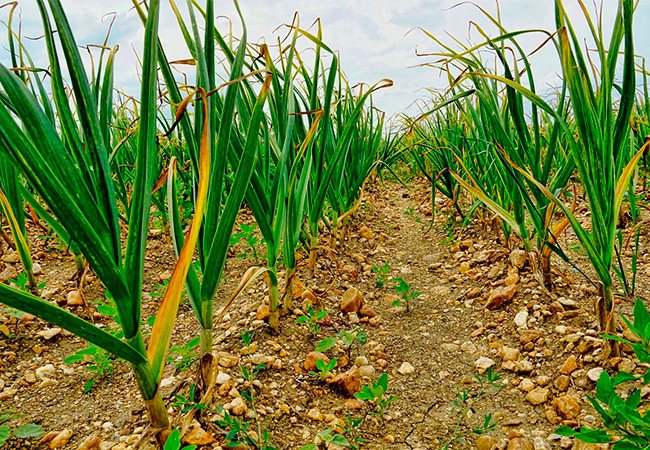

A change in color and drying out of garlic feathers in the second half of summer is a signal of the ripening of the heads, the imminent harvest. If, in May or early June, the leaves of winter crops turn yellow, the shoots of cloves planted in spring, then most likely the reasons lie in disorders of care, infections (see video).
Have questions? Ask and get useful advice from professional gardeners and experienced summer residents. Ask a question >>
Why does the feather or tips of garlic leaves turn yellow:
- violations in the timing of sowing culture. Winter garlic is planted in autumn, taking into account the time of the onset of cold snaps in a particular area.It is important that the cloves do not germinate before frost, otherwise they will not adapt to subzero temperatures;
- lack of certain nutrients, primarily nitrogen and potassium. With a nitrogen deficiency in early spring, plants have sluggish and small shoots, yellowish feather color, and the absence of a bright green pigment. If there is a lack of potassium, in addition to the yellowing of the leaves, the feather takes on a bluish tint, the border of the leaf plates turns brown ("burnt" edges). The lack of magnesium is expressed in the yellowing of the plate between the veins. Plants slow down their growth, look weak, frail;
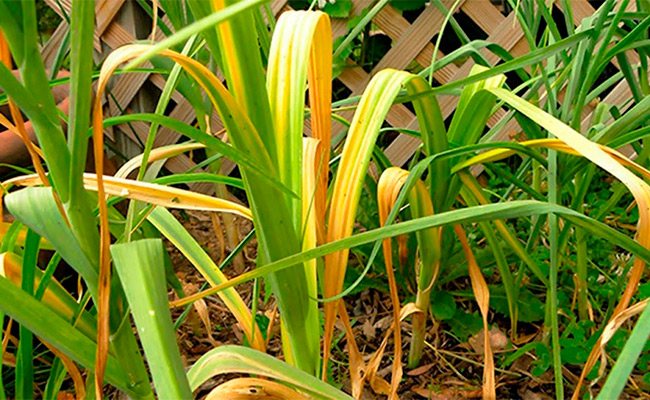

- garlic turns yellow in the garden - it means that in this place there may be increased indicators of soil acidity;
- insufficient watering. This culture needs regular irrigation, both drought and excess moisture are harmful and dangerous. With a lack of leaves above and below, change color from rich green to pale salad, whitish;
- spring chills also affect the development of plants. Recurrent frosts are dangerous when fragile shoots of spring and leaves of winter garlic are damaged;
- unsuitable place for planting garlic. The vegetable does not like lowlands, darkened areas;
- non-compliance with crop rotation. When garlic is grown for several years in a row, pathogens and crop pests accumulate in the same place in the soil. The soil is depleted, the plants get sick more often, the yield indicators decrease;
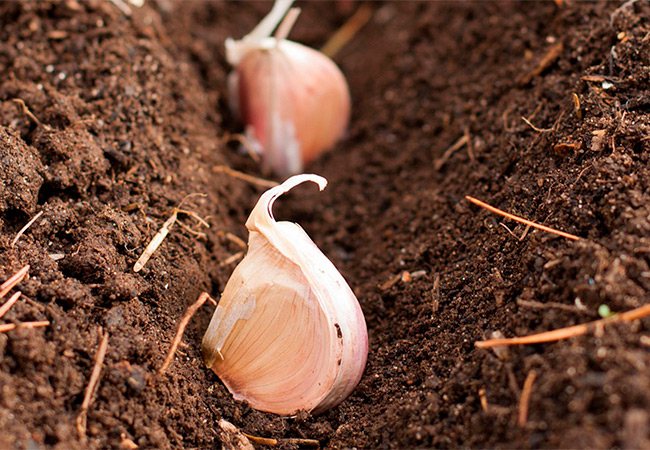

- deep or shallow planting of teeth. For winter garlic, which hibernates in the ground, this is especially important. With a strong or insufficient deepening, the cloves freeze slightly, and in the spring they give weakened, yellowing shoots;
- poor quality planting material;
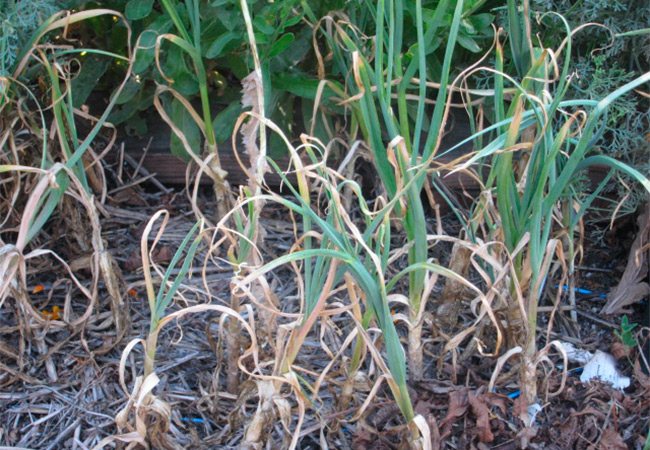

- disease. With rust, round yellow spots-plaques appear on the feathers, which turn red over time. Downy mildew causes yellowing of the upper leaves and drying out, and with fusarium, the bottom of the head rots and the tips of the leaves turn yellow;
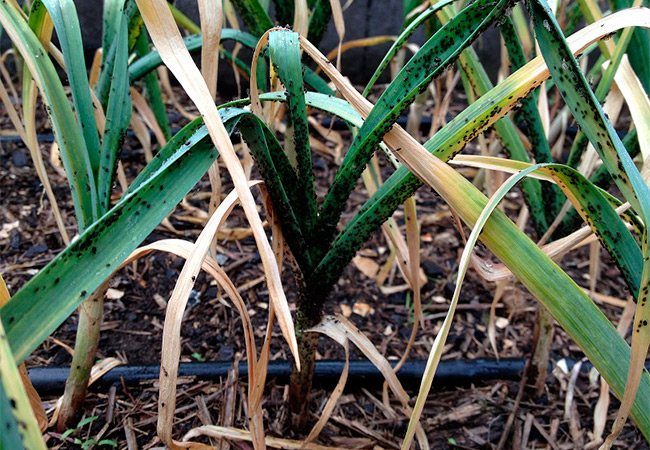

- damage to plants by pests (tobacco thrips, garlic mites, nematodes).
Seeing that the tips of the leaves or the entire feather turn yellow in garlic, they first identify the cause, and only then they carry out the treatment.
Watering errors
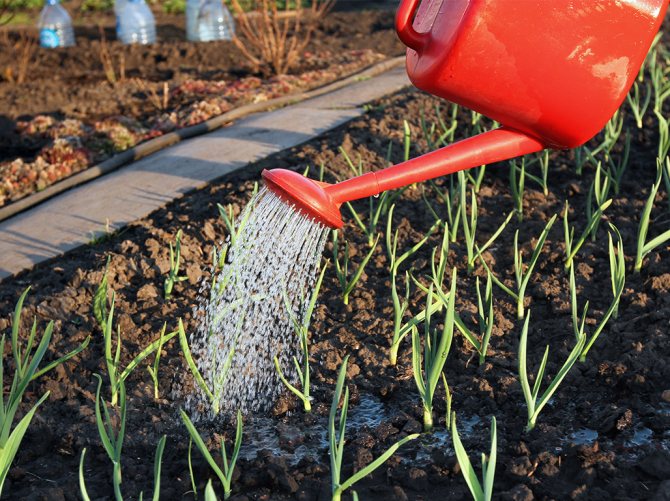

Garlic prefers moderate irrigation. If there is not enough water in the soil, the leaves begin to dry out. In the spring from April to May, plants are watered three times a month. Then watering is reduced, canceling out a month before digging out the crop.
On a note! To better preserve moisture, the soil on the garlic bed is loosened. Loosening is useful for improving aeration of the underground part of the plant.
The oversaturation of the soil with water is even more dangerous than the lack of moisture. In this case, the underground part of the garlic suffers. She lacks oxygen, decay begins. Therefore, irrigation of plants is carried out taking into account the weather. If the spring is dry, watering is done more often. In rainy weather, irrigation is completely abandoned.
Improper watering
Lack of moisture, as well as its excess, is harmful to plants. Garlic reacts to this with the same yellowing of the leaves. It tolerates drought better, but cannot completely do without watering. On average, garlic beds require abundant irrigation once a week. The greatest need for moisture is observed in the culture in May - June.
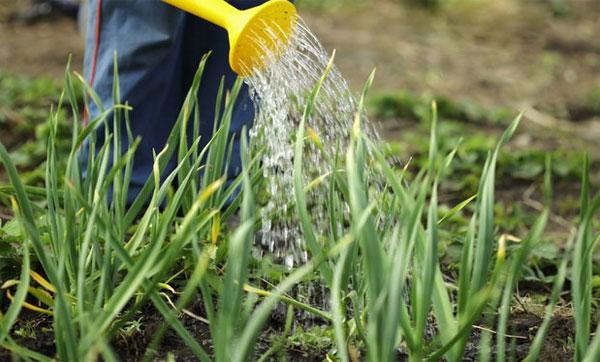

If the season is dry and there is no rain, planting spring and especially winter garlic in spring should be watered from the first warm days. In the rainy season, the procedure may not be carried out.
Increased acidity of the soil
Sometimes the yellowing of the leaves of garlic is due to improper soil composition. The plant grows actively, feels good and gives a rich harvest if it is grown in light soil with a neutral or slightly acidic reaction. If the acidity is increased, the garlic starts to hurt.
You can eliminate the increased acidity by liming the soil. Slaked lime is added to the soil. Depending on the level of acidity, add from 300 to 700 g for each square meter of soil.After distributing lime over the surface of the bed, it is carefully dug up.
Folk remedies
There are also folk remedies for treating garlic from yellowing. Let's take a look at some of them:
- A very effective method would be to water the beds with garlic with table salt (2-3 tablespoons of salt in a bucket of water).
- One of the most versatile is a solution of ash with water. You need to mix 1 kg. ash with 1 bucket of boiled water, let it brew for a couple of days. Then mix thoroughly and pour with this solution.
- Ammonia will help from pests, it will also saturate the soil with the missing nitrogen, it should be diluted in water correctly (60 ml per 10 liters of water) and watered.
- Due to the coolness of the night, the beds should be covered with a 5-8 cm layer of mulch.
- Levamisole chloride solution. For 1 liter. warm water will need 1 tablet.
- By planting calendula or tagetes between the rows of garlic, you will provide the vegetable with getting rid of parasites, because the juices of these plants are poisonous to them.
- Using copper sulfate as an alternative to ash. Dissolve 1 spoon in 1 bucket of cold water, let it brew a little and water the plant.
Diseases of garlic
The appearance of yellow spots on the lower leaves of garlic indicates the development of peronosporosis. A moldy coating forms on the bottom of such a sheet plate. After a short time, the leaf becomes covered with mucus and dies off.
To combat peronosoporosis, the following drugs are used:
- "Fentiuram" in the amount of 3 kg per 10 liters of water;
- "Polycarbocin" in a solution of 40 g per 10 liters of water;
- "Arcerida" is a solution of 30 g of the drug and 10 liters of water.
Under the influence of these funds, the activity of the fungus slows down. To increase immunity, top dressing is used.
Rust is another common disease in garlic. First, small rusty spots appear on the leaves. As the disease progresses, their size increases. Treatment with Ridomil, Oksikhom, Bravo will help to eliminate rust. These agents have a fungicidal effect, suppressing the activity of the fungus. They are processed every 2 weeks, but watering is stopped a month before harvesting.
Diseases and pests
Some diseases of garlic cause the foliage to turn yellow. The main types of diseases affecting garlic:
- Fusarium. This is a fungal disease that affects seed and soil. Causes the appearance of stripes on the leaves of a yellowish-brown hue. The fungus develops in high humidity. You can get rid of the problem with a solution of potassium permanganate. They need to process the seed. For preventive purposes, it is supposed to treat the places for planting garlic with boiling water 3 days before planting.
- Peronosporosis. It develops with high air humidity and high temperatures. At the initial stage, spots of a pale green tint appear, but gradually they turn into a gray bloom. In later stages, the leaves turn yellow and wither. To get rid of the disease, spraying with special chemicals is carried out.
- Rust. Basically, its distribution requires coolness and high humidity. First, small yellow spots appear on the tops, but gradually rust affects all the leaves. They take on an orange tint.
- White rot. With a disease, the bulb itself begins to rot directly. As a result, the ground part of the garlic begins to turn yellow. The disease will spread much faster if the weather is dry in spring. Also, the reason for the active spread of white rot is a lack of nitrogen. White rot will remain in the ground for up to 30 years, so getting rid of such a problem is very difficult.
- Basal rot. This is also a fungal disease, but it is not as scary as the previous options. With such a disease, the plant only weakens.Outwardly, everything resembles white rot, but the garlic will not wither quickly.
- Black mold. Because of this disease, the bulb itself becomes softer. A black coating can be seen between the scales. Leaves change color, become whitish or yellowish. The disease usually develops when the temperature regime is disturbed.
In order to prevent the appearance of various diseases and pests, you need to follow the rules of crop rotation. Additional plants can be planted between the beds, which are lifeguards.
Post Views: 3
Pest damage
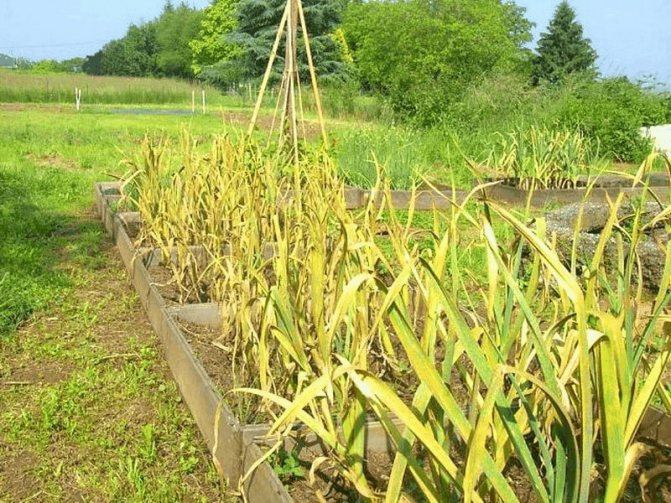

Garlic is susceptible to pest attacks. They weaken the plant, provoke yellowness on the feathers and rotting of the bulbs. The following insects are most often noticed:
- nematodes are very small worms that settle inside the garlic head;
- the onion fly makes clutches of eggs, from which the larvae then hatch, destroying the bulb;
- the garlic mite lives in the soil and is a carrier of viral diseases, feeds on the pulp of garlic, provokes the formation of yellow spots;
- tobacco thrips sucks the juice from the leaves of garlic, provoking the appearance of whitish spots.
Advice! You can scare away insects by planting strong-smelling flowers between the rows on a garlic bed. It can be marigolds or calendula.
At the initial signs of pest damage, folk methods are used to combat them. The following substances help well:
- A decoction of 3 kg of tansy flowers and 10 liters of water. After boiling it is cooled, filtered and sprayed with plant liquid.
- Nettle broth is prepared from 1 kg of green grass and 10 liters of water. After boiling, it is left for 5 days in a closed container to ferment. Then the liquid is filtered and diluted with water at the rate of 1:50. Garlic greens are sprayed with this solution.
- In 10 liters of water, dissolve 25 ml of ammonia and process the aerial part of the garlic.
- A solution of salt 200 g per 10 liters of water helps well against onion flies. The liquid is sprayed onto the green part of the plant. The next day, the plantings are treated with clean water.
If the plants are severely affected by pests, folk remedies show low efficiency. Then insecticidal preparations are used:
- solution of the drug "Actellic" at the rate of 2 ml per 2 liters of water helps to cope with ticks;
- the drug "Summer resident" in the same concentration eliminates the onion fly;
- the preparation "Carbation" is used to treat the soil in August against nematodes;
- insecticide "Vidat" 2 g is added to each well during planting of garlic to protect against nematodes.
Why does garlic turn yellow in spring
Knowing the cause of this phenomenon and the ability to correctly determine it will help every gardener to cope with the problem and prevent it from happening again in the future. There are five main causes of yellowing of garlic:
- severe frosts and frosts,
- poor seed quality,
- wrong boarding time,
- diseases and pests,
- excess or lack of moisture in the soil,
- increased acidity of the soil,
- lack of micro- and macroelements in the soil.
Now let's talk about each in more detail and see what to do if the garlic turns yellow in the spring?
Severe frosts and frosts
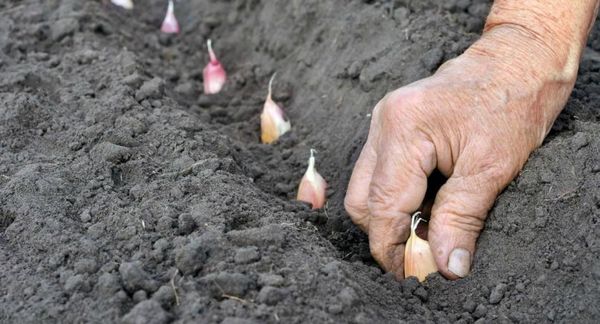

This is the most common reason. There may be two options for why the winter garlic turned yellow:
Planted too early
Planting timing is extremely important for any plant, and garlic is no exception. If it is planted too early, then it can have time not only to take root, but also to put down the first leaves.
In the spring, this will certainly lead to yellowing of the leaves, since it will not be difficult for frost to damage them.
- For the middle lane, the optimal time to plant winter garlic is October.
- For the southern regions, it is better to choose November.
Severe frosts in winter or frosts in early spring
This option does not depend on the human factor, since it is almost impossible to influence the weather conditions.As in the previous case, the first leaves of winter garlic can fall under spring frosts, which will result in their yellowing.
Severe frosts in winter can cause not only yellowness, but also complete freezing of the roots.
Not planted deep enough. This is one of the common reasons why garlic leaves are already growing yellow or with yellow tips, and is also associated with frost. Recommended planting depth: 4-6 cm.
To avoid these consequences, garlic planted before winter should be mulched with leaves or dry grass. Then, under a thick layer of mulch, frost will not be so terrible for garlic.
If it was not possible to avoid the negative effects of frost, then you will have to use biological products that can help garlic cope with the consequences.
After frost, it is recommended to spray the garlic with Zircon, Epin, Succinic acid or other stimulants - it will help restore the culture and activate growth.
Excess or lack of moisture in the soil
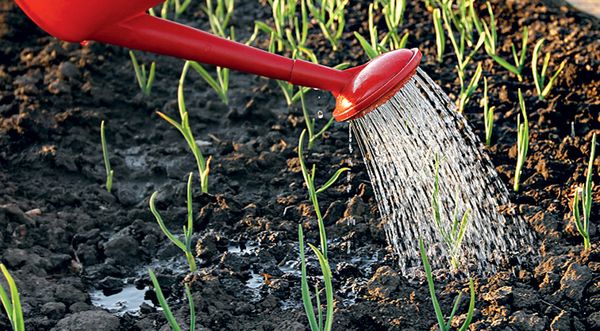

The yellowing of the upper and lower leaves of garlic is often observed in dry and rainy weather. This is due to a violation of the air-water balance.
Regular but moderate watering is important for garlic. Especially in May and June.
It is necessary to loosen the soil to allow air to reach the roots of the plant.
Remember that over-watering garlic is more difficult than under-watering. Therefore, mulched beds should be watered as needed.
- In the spring months, in normal weather, water it two to three times a month.
- Dry - more often.
- With frequent rains, it is completely better to refuse watering.
They completely stop watering the garlic before harvesting it - for a month.
Diseases and pests
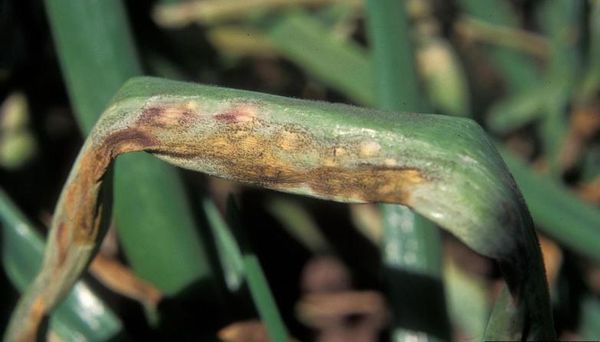

Photo: Downy mildew
Garlic is a crop that is often used to fight diseases or pests, but it also has its "enemies". They also often cause its leaves to turn yellow due to the damage they inflict.
The main diseases and pests of garlic:
- downy mildew;
- rot;
- rust;
- mold;
- nematode;
- mite;
- onion fly;
- mole.
To determine what is the main reason - you need to dig out a head of garlic with yellowed leaves. See if there is rot, rotten roots, mold, larvae at the base of the bulb, or pink bloom on the bottom of the bulb. If any of the above is present, you have found the cause of the yellowing.
How to process garlic in spring?
Here it is necessary to apply spraying with special fungicide preparations to combat diseases, and for an onion fly it is better to do a mixed planting, but there are no effective recipes from a nematode.
Saline solution will help with parasites:
- 200 g of salt
- 10 liters of water.
Used for watering beds about 1 glass per plant. The next day, be sure to rinse with clean water!
Now read:
- Why is it impossible to be late in harvesting garlic?
- Why does the onion turn yellow in the garden and what to do about it
- Why does petunia turn yellow and how to deal with it
- Planting garlic in the fall before winter. When to plant garlic in autumn
- Onion
In a similar way, you can use a pink solution of potassium permanganate.
The best remedy for diseases and pests is prevention.
More information about crop rotation in the garden.
A few recommendations:
- Apply the principles of crop rotation to garlic without planting it for several years in a row in the same place.
- When planting garlic, treat the cloves with fungicides.
- To prevent the accumulation of diseases, you need to change the seed at least once every 4 years.
- For the prevention of nematodes, calendula, mint, marigolds, coriander are planted next to garlic, the roots of which are poisonous for it.
- You should not use fresh manure for feeding garlic.
Increased acidity of the soil
For planting and growing, garlic requires neutral soil acidity.If there are problems with high acidity, then you need to fix it - for this, digging up the earth, add lime.
Nematoda lives in acidic soils, solving this problem will help get rid of the parasite.
It should be introduced gradually directly under the digging, that is, immediately mixing with the ground. Lime quantity:
- very acidic soil - 60 kg per hundred square meters,
- medium acid - 45 kg,
- slightly acidic - up to 30 kg.
Lack of micro- and macroelements in the soil
If none of the previous reasons are suitable (the weather is warm, there are no diseases and pests, everything is in order with watering and acidity of the soil), and the leaves of the garlic still turn yellow, then there is only a lack of micro and macroelements in the soil.
If the lower leaves turn yellow, this may mean that nutrients are spent on the formation of future heads of garlic.
The most common causes are lack of nitrogen, magnesium or potassium in the soil. This can only be corrected by top dressing.
- in early spring - lack of nutrition (the roots grow slowly and do not have time to provide the plant),
- at other times - a lack of nitrogen,
- when grown on poor soils - a lack of potassium is possible.
Prevention
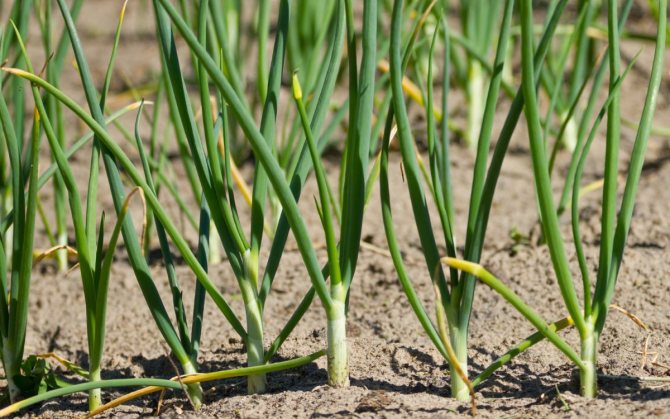

You can prevent possible problems when growing garlic with proper planting and good care. Planting in the central part of Russia is completed by mid-October. For the southern regions, this period is shifted to mid-November. Garlic is planted taking into account the rules of crop rotation. In one place, it should not grow for more than two years. This culture feels best if its predecessors were cabbage, pumpkin or zucchini.
During planting, the soil is dug deeply with the simultaneous introduction of compost or mineral complex fertilizers. Planting material for protection from pests and bacteria is treated with a pinkish solution of potassium permanganate or the drug "Maxim". Before planting, the heads of garlic are carefully inspected, rejecting the damaged one. For the planting material to adapt better, it is useful to treat it with Epin.
To prevent rot, fusarium, powdery mildew and other diseases that develop in hot and humid environments, the soil around the plants is loosened if the summer is rainy. This measure helps to reduce soil moisture. Plants are periodically sprayed with a solution of ammonium carbonate salt of nitrogen. This drug reduces the likelihood of pest infestation. To reduce the activity of nematodes, soil deoxidation is useful. These insects do not live in a neutral or alkaline environment.
The harvested crop is dried for 2-3 weeks before being sent for storage. Also, it is carefully examined, separating the damaged heads. The garden bed is dug up after harvesting. All plant residues are collected and burned.
Useful properties of garlic
Garlic produces active substances that are presented as phytoncides. Biological enzymes suppress or destroy harmful bacteria in the body. It has been proven that the vegetable is effective against diphtheria bacillus, streptococci and staphylococci.
Fresh articles about garden and vegetable garden
Bacopa ampelous: photo, cultivation and care
Andrey Tumanov garden and vegetable garden: useful tips
Biofungicides for plants
Garlic has powerful analgesic and antiseptic properties. The composition can be applied externally for non-healing and festering wounds. The vegetable can easily reduce warts, calluses and inflammation after insect bites.
Garlic brings invaluable benefits to the human body due to its allicin content. The substance is considered to be the most powerful bactericidal agent. Even in small quantities, the enzyme causes colossal harm to pathogenic bacteria.
In folk medicine, garlic is most often used to treat colds. To suppress the activity of harmful microorganisms in the oral cavity, it is enough to chew a clove of a vegetable.
As for allicin, the enzyme, entering the body, relieves stress from the walls of blood vessels. This phenomenon has a positive effect on a person's cardiac activity.
Scientific studies have shown that peoples who regularly eat garlic are the least susceptible to cancer. Modern medicine has proven that phytoncides reduce the risk of all kinds of tumors.
Experts recommend including garlic in your diet. Regular consumption of the product destroys intestinal parasites and their activity in the gastrointestinal tract. As a result, garlic has a positive effect on human skin.
Against the background of useful properties, this plant can be dangerous. The vegetable is recognized as a harmful crop for pets, so you should not feed your pets with dishes from the table with its addition. It can be dangerous to the walls of the stomach, causing ulcers. After consumption, there is a burning sensation in the mouth, contributes to bloating. Bad breath, diarrhea occurs when consumed without heat treatment.
Testimonials
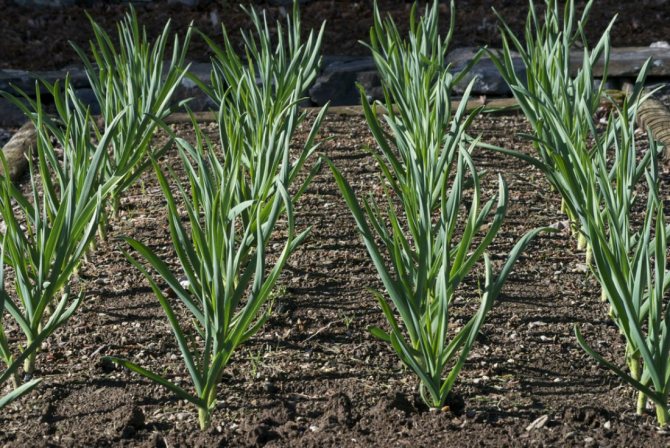

Evgeniya, 33 years old:
When growing garlic, I faced the problem of yellowing arrows. It turned out that the wrong landing was to blame. In the fall, I planted it too shallow. Therefore, it got a little bit cold. I had to spray the plants with Zircon. A few days later I noticed that the yellowness was passing.
Semyon, 42 years old:
In the spring, winter garlic became lethargic and small, and yellowness appeared on the green feathers. I had to feed him with urea. First, I applied dry fertilizers, and after a couple of weeks I poured the garlic with a solution. Soon the arrows went up and turned green.
By performing all preventive measures, you can avoid infection with diseases and pests, and achieve high yields. If it was not possible to avoid yellowing of the garlic leaves, you need to identify the cause. Then, heal the plants using the correct methods.
Influence of insect pests
Despite the fact that garlic is not a crop with a pleasant taste, it finds its "admirers" among insects, whose vital activity can lead to loss of crops. It is worth dwelling a little more on what kind of insects your garden can attract, and what to do in case of their invasion. Most often, garlic is attacked:
- Stem nematode - a worm that first penetrates the tissues of garlic, and then makes a clutch of many eggs in them. Over time, larvae appear from them, penetrating the head of the garlic. The vegetable reacts to this by curling and yellowing the leaves. To destroy the worm, the planting material must first be held in salted water, and then transferred to clean water heated to 40 degrees. The garden bed can be surrounded by rows of marigolds, mint, coriander, savory or calendula, which repel pests. At the end of the season, wood ash must be added to the soil. To protect plants from nematodes, agronomists advise not to plant garlic the next year after onions and potatoes;
- The onion fly hibernates in the soil in the form of pupae, and with the onset of spring begins to actively lay eggs near the garlic. The larvae of this fly burrow into the soil, penetrating the middle of the garlic head, which leads to rotting of the bulbs, yellowing and lethargy of the leaves. To level this factor, you need to add tobacco dust mixed with sunflower ash to the soil before planting, and plant the garlic, alternating it with carrots. If you noticed the intruder too late and did not have time to take preventive measures, you can save the crop by adding ammonium carbonate to the beds.
Why does garlic turn yellow in the garden in spring
It is difficult to imagine a home plot without a garden of garlic. This plant is both a favorite seasoning for many dishes and a remedy for colds. In the spring, for many, even experienced gardeners, garlic begins to turn yellow for no apparent reason.
This trouble can happen at different stages of plant development, but mainly with the question "Why does winter garlic turn yellow: what to do, what to water?" gardeners contact us in early spring, at the beginning of the gardening season.
There can be several reasons for this phenomenon. In order to determine which factor negatively affected the plant, it is necessary to analyze how the garlic was planted: at what time, to what depth, in what soil, what planting material, and also in what conditions the plant is at the moment.
The reasons why the tips of the leaves turn yellow in garlic in the garden
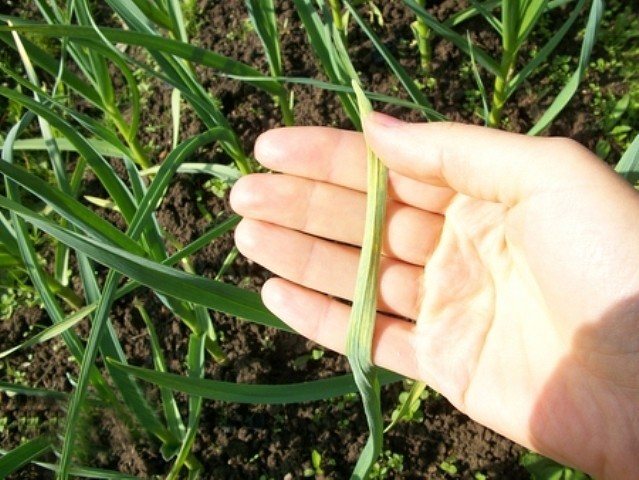

Winter garlic is planted before winter. And you can immediately name two mistakes of gardeners, which lead to spring yellowing of the leaves of garlic.
- The first and most basic reason is the soil that is poorly prepared for planting. Failure to comply with crop rotation leads to the accumulation of pathogens and pests in the soil.
- The second reason is the wrong planting: they made a mistake with the sowing time, planted too shallow or too deep.
Plants remove nutrients from the soil every season. Before planting winter garlic, you need to restore its fertility, add organic matter and mineral fertilizers. With a lack of basic micro- and macroelements in the soil, the nutrition of garlic is disturbed, which leads to a change in the color of the feather.
Important! Use quality planting material. When stored in a damp room, the heads become infected with black mold spores. After planting, the bulb of the infected plant rots, the feather withers and turns yellow.
Yellowing of leaves usually occurs when nitrogen is deficient. This nutrient is easily washed out of the soil during prolonged rains. If there is not enough magnesium or potassium in the soil, then the roots develop poorly, the heads do not increase in size, the aboveground part of the plant turns yellow and gradually dries up. Marginal leaf burn is the main sign of potassium starvation.
Before planting garlic, it is necessary to check the pH level (the norm is 6.5-7.9), on acidic soil the culture develops poorly, is susceptible to disease and often suffers from pests due to weakened immunity. Garlic does not turn yellow and gives good yields on loamy and sandy loam soils.
The relief of the suburban area is not always even. Winter garlic grows worse in lowlands, where water stagnates, and on highlands, where snow does not linger. In both cases, immunity suffers. Excessive moisture provokes fungal diseases, lack of snow in winter - freezing of the earth layer and freezing of the heads.
Not only gardeners' mistakes when planting lead to yellowing of garlic leaves in spring. Weather conditions play a big role:
- return frosts;
- dry, hot spring;
- rapid warming up and drying out of the soil;
- rapid melting of snow and frequent spring rains.
Useful Tips
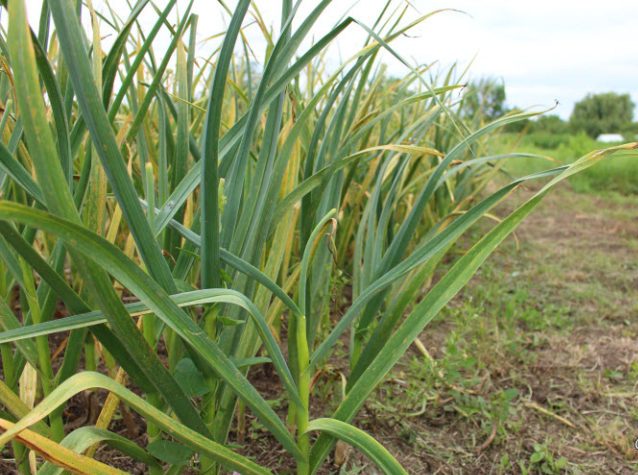

It can be concluded why yellow feathers begin to appear on the garlic bed in the spring. The weather (cold snap), depleted soil, invasion of pests, infection or mistakes in agricultural technology are to blame. When the first yellow leaves appear, it is necessary to establish the correct diagnosis and, with the help of our advice, help the garlic:
- do not plant garlic after bulbous crops;
- before planting, treat the seed with Fitosporin, Maxim or manganese solution;
- reduce soil acidity by adding dolomite flour during plowing;
- observe the timing of planting winter garlic (middle strip - mid-October, south - November);
- adhere to the correct planting depth (5 cm);
- cover the planting with covering material from frost.
What to do if garlic turns yellow
The problem cannot be ignored. After analyzing the possible cause of yellowing, you need to start treatment or control when it comes to pests. Garlic that turns yellow in the spring must be fed. From agrochemicals, Agricola, Kemira Fertika and other modern preparations are suitable.It is necessary to dissolve the substance, as indicated in the instructions, and spray the plantings from yellowness or water the soil under them.
Fertilizers and agrochemicals
If the feather turns yellow due to cold, the leaf should be sprayed with “Zircon” (8 drops per bucket of water) or “Silk”. The latter contains triterpenic acids - natural fungicides produced by conifers. Stimulants will accelerate the growth of the root system and strengthen the immune system of the crop.
It has a beneficial effect on the weakened plant "Epin" (1 mg is diluted in 5 liters). This drug is also good because it can be used many times, once a week, until the garlic recovers.
The adaptogen substance in its composition is a real antistress for plants that have survived a cold shock. The stimulant also encourages the garlic to quickly eject new shoots to replace the diseased ones.
In addition to agrochemistry, mineral and organic fertilizers must be used to save the culture:
- Potassium sulfate will increase cold resistance (20 K per bucket).
- To replenish nitrogen reserves in the soil, the garden bed is watered with a urea solution (25 g per 10 l of water). The leaves are sprayed from a spray bottle.
- To strengthen the heads, superphosphate is used (2 tablespoons per 10 liters).
- Ammonium nitrate is used once every 3 weeks (15 g per bucket).
- Nitroammofoska will enrich garlic with potassium, sulfur phosphorus and nitrogen (1 tablespoon per 10 liters).
- Succinic acid (a product of amber processing) will increase the plant's immunity, it will be easier to tolerate temperature extremes (1 g is stirred in a small amount of warm water and the volume is brought up to 1 liter). It is sprayed with the affected leaves.
Loading ...
Folk recipes
In addition to macro- and micronutrient fertilizers, it is very useful to use folk remedies. Garlic is responsive to two-year-old humus; it can be mulched with a garden bed by mixing it with straw. So the plant will receive additional nutrition. If, after this procedure, yellowing continues, then the matter is different.
If the garlic turns yellow in the spring, you can feed it with ash, which contains potassium. Bulbs grow strong, the plant acquires resistance to pests. A bed that is not covered with mulch can simply be sprinkled with ash over the plantings. It is undesirable to mix humus and ash. The latter can be brought in during the digging of the garden, before planting, or periodically water the vegetable in the spring so that it does not turn yellow with it.
Recipe for spring dressing of garlic: pour 300 g of ash with boiling water and leave for 20 minutes. Strain, bring the resulting volume to 10 liters, dissolve the planed laundry soap in it for better adhesion.
Prevention of yellowing of garlic
As you know, it is always easier to prevent than to cure for a long time. In order not to find yellow garlic in the plantings at the beginning of summer, you need to be guided by the rules:
- Crop rotation plays a key role in growing healthy plants and preventing disease. Garlic can be planted on the previous garden bed only after three years, during which time pests, as well as spores of fungi and microbes that are dangerous to it, will disappear.
- It is extremely important to observe the timing of planting winter and spring garlic. In the fall, the heads should not move into growth and discard the feathers, and in the spring, the teeth should be planted after return frosts in the warm ground.
- Choose healthy planting material, without stains, rot and damage to the integrity.
- The soil must be ph-neutral, otherwise it will have to be deoxidized by adding a choice of lime, dolomite flour, ash, eggshell, chalk.
- It is forbidden to throw fresh manure into the ground during planting, it may contain disease spores.
Evenly colored green leaf plates of garlic without spots, dryness indicate the health of the crop, which means its high yield.
What to do if garlic turns yellow
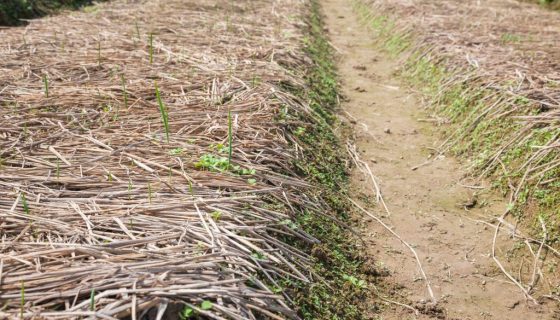

There are several reasons for the yellowing of garlic
To fix this problem, you need to figure out why the garlic turns yellow. Let's talk about how to fix each problem separately.
Frost
Most often, winter garlic turns yellow during frost.To protect the beds from frost, they should be mulched. For mulching, use humus, peat, small shavings or straw. It is best to mulch the soil with organic matter, which serves as a fertilizer for vegetable crops. To protect the planting from frost, lay at least a 5 cm layer of mulch.
Sometimes in spring, summer garlic, planted too early, turns yellow. Before starting planting a crop, they check if the soil has warmed up and watch the weather forecast. Sometimes the reason that winter garlic turns yellow is failure to comply with planting dates. In the southern regions, vegetable crops should be planted no earlier than November.
In the middle lane, a vegetable is planted in September or early October. after planting, the soil must be mulched. This helps the plant survive severe winter frosts. In this case, it is best to mulch with leaves.
If the tips of the garlic leaves turn yellow, the situation can still be saved. In the store, they buy any growth stimulant for plants and treat the culture with this solution.
Poor care
Garlic leaves often turn yellow due to improper care. If there is little rain in the spring, the plant is watered 2 times a week. If there is no precipitation, the vegetable crop is watered 2 times more often. If there is too much rain in the spring, the crop should not be watered. Does not require watering and a vegetable mulched with humus. The plant tolerates excess moisture worse than its lack. The next day after watering the soil is loosened.
Lack of minerals
In addition to timely watering and loosening the soil, the culture needs to be fed. In early spring (April-March), mineral fertilizers are applied to the soil. To do this, a furrow is made between the beds and fertilizer is poured there, after which the furrow is poured and the entire area is watered. Since it is impossible to determine which microelement is missing, complex means are used. They must contain potassium, nitrogen and magnesium.
After the emergence of seedlings, foliar dressing is carried out with mineral fertilizers (May-early June). Also, a young vegetable in May can be fed with organic matter. The second foliar dressing is done in the summer (June-July).
If the stem and shoots of the plant look powerful, you should not be zealous with feeding. An overabundance of microelements has the same negative effect on the plant as their lack.
Soil composition
If the tips of the leaves of winter garlic turn yellow immediately after germination, then most likely the matter is in increased acidity. You can lower the acidity of the soil by using wood ash. True, you won't be able to get by with a few handfuls of ash. The site must be abundantly covered with this natural material. If we talk about norms, to lower acidity by 1 sq. m of land make about 700 g of ash. Alternatively, you can prepare a solution of ash (for 8 liters of liquid 200 g of ash). Even the plantings of a young vegetable, which has turned yellow, are watered with this solution.
You can lower the acidity of the soil with lime. 40-50 kg of lime is applied per one hundred square meters. It is best to introduce this natural material before winter. We do this while digging a vegetable garden. When mixed with soil, the desired effect is achieved faster. After liming, crops that need neutral soils can be grown for 10 years. After this time, liming is repeated.
You can lower the acidity of the soil using green manure. In late August or early September, rye, oats, white mustard or phacelia are planted on the site. The green mass is mowed before buds begin to form. It is buried in the ground. It is advisable to mow green manures 2 weeks before planting white cloves.

